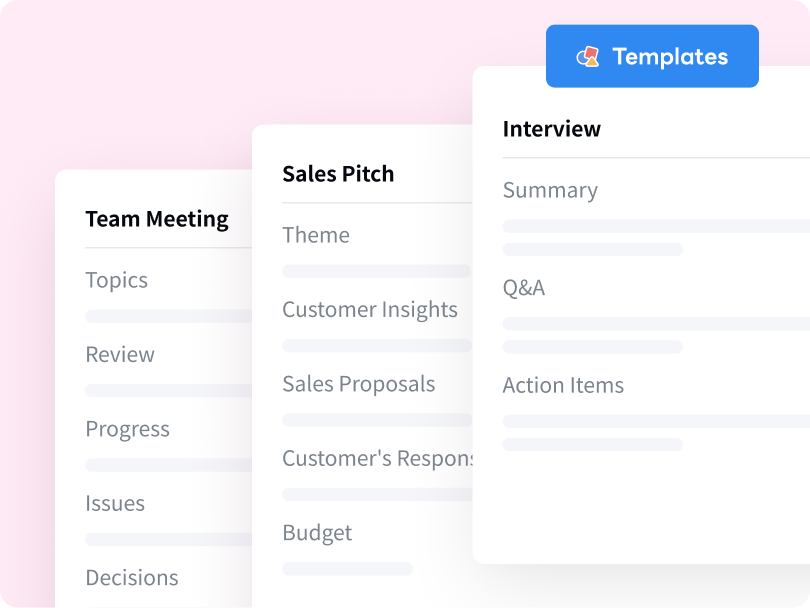
How to Write an Objective Summary (With Example)
Record, transcribe and summarize conversations with one click.
Most weeks, I'm writing 8000+ words for my clients — and most of these times, I need to summarize the extra lengthy documents for my research. I'm only able to do that because I have a proper plan in place — from understanding how to write an objective summary to automating certain tasks using artificial intelligence.
I'll be honest: writing an objective summary of a press piece, document, or video is more difficult than one can imagine. You'll need to gather the important details, create a brief outline, and then finally start the writing process. You cannot talk about personal opinions, nor can you include non-essential details.
Here's how to write an objective summary with examples — with a clear roadmap so you don’t have to waste your precious hours.
What is an objective summary?
An objective summary is a short, meaningful text that describes the main thesis — along with the supporting statements related to any video, presentation, report, or other content. It's helpful for anyone who wants to read a concise, informative version of the long document (video, press release, or anything you name) — and then decide if they wish to read the document from start to end.
How to write an objective summary?
Everyone knows the feeling of opening a lengthy document, staring at large blocks of text, and feeling like they're lost in words. Creating a summary gives the viewers — and you — a fair idea of what's more important in the document or video, what elements can be included or omitted, and a general overview of the whole piece.
So, how to write an objective summary without burning hours? Here's the process I follow — and you can tweak my process as needed or remove the steps that don't make sense to you. Remember, the only goal of an objective summary is to make your (and all your readers) job easier.
Read the original work
Carefully reading the original work will help you prepare the outline, help you understand what to include in the summary, and give you a detailed roadmap for writing an objective summary. Depending on the complexity of the document and its length, an objective summary can be as short as a few paragraphs or as big as one page.
Take proper notes
If you have any basic idea about writing summaries, you'll probably understand the importance of taking proper notes. Without a proper note-taking process, you'll be lost with so much information available in the document. I prefer taking notes in the form of brief bullet points so I can quickly refer to them when I sit for writing.

Start writing in your own words
Once you're done with reading and have created proper notes, the next question is how to start an objective summary. In this most important step, you have to extract only the main ideas that relate directly to the central thesis of the article. More importantly, focus on writing everything in your own words — while keeping it short, succinct, and straightforward.
Focus on factual statements
An important element of an objective summary is avoiding the use of your own opinions — and sticking only to the factual statements. If you want to make your objective summary worth reading, start with the core thesis in one sentence. A perfect, strong opening sentence will have three main elements: who is the speaker, what they are saying, and how they are saying it.
Add key points to support the statement
Remember, the opening statement can hold someone's attention — but the main body of the summary will include the supporting data. Generally, 1-3 supporting elements are enough to create a compelling summary.
Once I finish the objective summary, I read it through to see if there are any grammar or spelling errors — and, more importantly, if there's some important information left behind while summarizing. My reviewing and editing process is the last but most important step that always proves to be a game-changer.

Notta offers the most integrated AI meeting notes, summaries, and action items so nothing gets missed.
Example of an objective summary
A summary and an objective summary are two very different things. While writing the summary: you don't have to be shy about the details or stating your opinions. Your aim is to provide readers with a comprehensive overview of the document you're summarizing. But that's different from an objective summary — where you can neither state your opinions nor there's a need to summarize all the details.
Here, I'll show (not tell) you one objective summary example — so you get some inspiration to write your own summary.
Be clear and start with the main idea. The first thing you'll need to include in the summary is the central idea or the main characters (in case you're summarizing a story).
Example: In Hamlet play, William Shakespeare reveals the main characters, such as Hamlet, Ophelia, and Laertes — and outlines the main plot of the play (that includes the investigation story of Hamlet finding who murdered his father and why.)
The next step is to share the supporting data that go hand in hand with the main plot. Pro tip: Don't add any unnecessary details that might not directly relate to the central idea.
Example: You can leave Guildenstern and Rosencrantz parts in Hamlet's objective summary.
While writing the objective summary, be as specific as you can — and ensure that the tone and voice of the summary reflect the idea of the main idea without sounding opinionated. If you are writing an objective or summary for resumes, you’ll need to highlight your skills and professional highlights in 2-3 sentences.
Tips for writing an objective summary
Objective summaries aren't meant where you show your opinions — instead, it's the place where only the facts are recorded. An objective summary's purpose is to give the main idea about the story — by covering only the facts. Here, I've listed some more tips that'll ensure you're on the right track.
Record only the facts
Before I start writing the summary, I try to spend a few minutes carefully reading the document and noting down the facts (only). This step typically includes understanding the document's objective, formatting and tone, and any other important information that's necessary to nail the summary.
Use the AI summarizer app
I find it easier to write an objective summary of the video once I have an accurate transcript ready. If you're planning to summarize any audio or video file, it's best to use an AI note-taking, transcribing, and summarizing app like Notta.
It's a powerful AI tool that can generate transcripts with 98.86% accuracy — which can then be summarized in different key chapters, action items, and an overview. What I really like about the Notta AI Summary Generator is its ability to do the job faster and better.

Simply select the summary template that best fits your needs, and watch as Notta transforms your raw notes into polished, concise summaries. Your time is precious – let Notta help you make the most of it.
Keep the tone professional
Building out a detailed outline of a document is a smooth ride from here. With a general direction to your piece and extracting the main ideas from the document, all that's left is to write the summary in a professional tone.
Want the convenience of automated note-taking and AI summaries? Try Notta for your upcoming meetings.
FAQs
How long is an objective summary?
An objective summary should generally be one paragraph long — covering all the major points of the document. The word 'objective' here means something that's not influenced by one's personal opinions or feelings. While it should always be written in a short, concise format, it's not mandatory. Depending on the document you're summarizing, the length can range anywhere from one to a few paragraphs.
What are the 3 components of an objective summary?
The three main components of an objective summary include the central idea (the main topic or idea of the document), the supporting ideas (the facts or details that support the central idea), and then the objective idea (or the pure facts without anyone's opinion). With these three ideas in mind, it's time to start writing the summary — no matter what document you're summarizing.
Key takeaways
Writing an objective summary doesn't need to be an overwhelming task. With a little bit of planning and following the tips I have covered in this 'How to Write an Objective Summary' guide, you can get started right away. The steps outlined in the article will make your summarizing process more efficient, less challenging, and smoother.
Of course, you can use AI summarizers like Notta to automate the tasks on this list — such as converting the speech to text and then summarizing it into meaningful content. With the help of this AI note-taking application, you can keep most of your work-related systems running smoothly — and objective summaries are no exception.